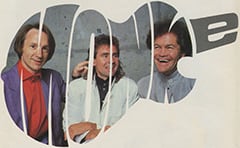
This article originally appeared in the Dec. ’86 issue of CREEM.
One of the worst aspects of rock ’n’ roll is that it’s often centered on this debate as to whether something is “cool” or not. Taste, like beauty, is always in the eye of the beholder—but it sure makes for humorous observations today when someone uses musical phlegm like Depeche Mode as a “cool” status symbol. Besides, if rock ’n’ roll really is (was?) the populist artform and anyone can do it, then “cool,” like pretentiousness, shouldn’t even enter the picture. Anyway, when I was 10 years old, the Monkees were “cool” to all my friends. When you’re 10, what’s cool is pretty much based on what moves you (or at least what you’re conditioned to be moved by)…
Of course, I wish I’d seen the Beatles, and I probably would have if I hadn’t seen the Monkees. But my mom took me and my six-year-old brother to see them in Detroit, which was over two hours away from where we lived and the only place you could see rock concerts back then. Anyway, the Monkees were really, really neat. Jimi Hendrix definitely didn’t open for them, but they rocked (they played their own instruments, there was no “hidden” band behind them), even if you couldn’t hear most of it (I distinctly do remember “I’m A Believer,” though) with 25,000 teenagers screaming non-stop for an hour. The teenage girl next to me cried—real tears and everything—throughout the show. My brother, a hyperactive kid to begin with, thought it was great ’cause he actually got away with jumping and screaming in public. My mother bitched all the way home, calling it “insanity” and “mass hysteria.” Like I said, it was really, really neat. Mike wore his wool hat onstage, and Micky imitated James Brown. Even though a white kid from a small rural town didn’t know much about James Brown in 1966, I would always remember that…
In 1973, I met Micky Dolenz outside the stage door of an Alice Cooper show. He was in town to emcee a rock festival, and he performed “The Monkees Theme” with the original Cooper band that night following their “School’s Out” encore. It was really, really neat. “Wasn’t that the fucking greatest show you’ve ever seen?” asked Micky, but he didn’t seem real eager to talk about the Monkees at that point in his life. Still, he was more than courteous when I told him how much I’d once enjoyed the “band”…
So the Monkees were “manufactured.” They were “commercialized.” They were “show biz.” They weren’t real. So what?? The same claim could be made about Alice Cooper, and it’s funny how his influence (be it good or band [sic], and it’s been both) has turned out to be more pervasive than that of, say, the ultra-cool Allman Brothers. Besides, I’ve read about the “Psychedelic Love Burgers” that got sold in Haight-Ashbury, and I’ve seen psychedelic pillowcases. It could be argued that the whole ’60s trip, “cool” or “uncool,” was “commercialized.” I mean, we used to watch the Vietnam war, people getting shot and stuff, alongside deodorant ads on TV in the ’60s. Like Noel Redding recently wrote of the Jimi Hendrix Experience, (who got their U.S. break opening for the “imitation” Fab Four): “Funny that groups like the Experience, who were symbols of the movement, were in reality just fronts for large corporations and small people who were using us and the audience in the madness of generating profits.” How “cool.”
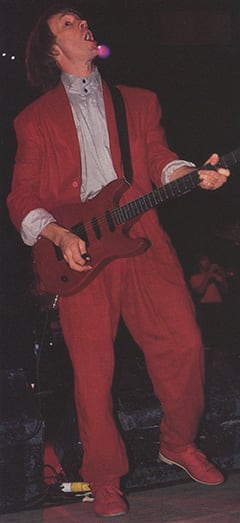
Plus, none of these arguments stand up much in the ’80s when the Monkees look pure in contrast to what’s accepted as “normal” today. I’d argue that Madonna, in her own way, is at least as “manufactured’ as the Monkees were. The Bangles just had two big hits with (gasp!) songs they didn’t write themselves! (Funny how some of the current critics who consider the Monkees a “joke”—many of whom must’ve been all of two years old in 1966—haven’t included, say, the great Darlene Love, of Phil Spector fame, who shared some composers with the Monkees, as part of their “joke.”) And don’t even mention Duran Duran, Sigue Sigue Sputnik or most of today’s heavy metal acts. Considering that the Monkees recorded in an (at the most) four-track studio as opposed to today’s 24-track studio where all kinds of things can be “punched in,” you’d better believe that a lot of current top bands don’t play their own instruments on records.
Of course, the Monkees did end up playing on a lot of their own recordings by the time of Headquarters (and even if they didn’t, does it really matter?). I’d argue that the Monkees produced much better music than all the current acts mentioned above, and that many of the Monkees’ best songs rate with any pop/rock music that came out of the ’60s. And the music is what it all boils down to in the end. Lots of the Monkees’ music still stands up today. Lots of it was great…
If the Monkees were a manufactured/teenybop/bubblegum band, then they were easily the greatest—and most ambitious—manufactured/teenybop/“bubblegum” band of all time. There’s no comparison between the Monkees and the Archies or the Bay City Rollers. Or Wham! Besides, if they were solely “bubblegum” (and they weren’t), is it really that derogatory to be “bubblegum”? The Replacements, for one, would tell you that it isn’t—and I know that I still turn up my radio every time I hear songs like “Tracy,” “My Baby Loves Lovin’,” “Indian Lake,” or “Love Grows Where My Rosemary Goes.”
OK, the Monkees were put together as part of a commercial TV show. But, for once, the people who put the thing together really lucked out. The Monkees proved to have genuine talent. Let’s not forget that the Monkees weren’t striving to be like Duran Duran. The Monkees wanted to be like the Beatles—and you can’t do any better than that. As a result, things as diverse as Hank Williams and Little Richard were part of their musical make-up. The Monkees strived to fit in the giant panorama that was ’60s rock ’n’ roll. In other words, there weren’t the factions and divisions that exist today. Pop was rock, rock was pop, and from Lesley Gore to Jim Morrison to Max Frost & The Troopers, it was all rock ’n’ roll. And be it bubblegum, pop, garage rock or psychedelia, the Monkees incorporated it all into their repertoire. More importantly, Micky Dolenz, Mike Nesmith, Peter Tork and Davy Jones were very charming entertainers. Every Monday night, they brought an element of ’60s pop culture into mid-American living rooms. In that sense, they were latterday Ricky Nelsons. Let’s not forget that things like long hair were still sort of taboo for mid-America in 1966, and the Monkees didn’t look that far removed from those kids rioting on college campuses. “It’s those bastards who ruined this country” in relation to the Beatles is a comment I heard more than once during the ’60s. If nothing else, the show’s existence was more than justified by its Yardley commercials which brought Twiggy-like models, Donovan singing “Wear Your Love Like Heaven” and images of swinging London into 10 million living rooms every week. The show was hip and innovative for its time, paving the way for Laugh-In, which in turn paved the way for Saturday Night Live. Plus, things did seem better in the ’60s. For the most part, people seemed more hopeful, if not happier. To be honest, I don’t think The Monkees series is really that terrific in retrospect, but I feel the same way about Elvis movies, and those were some of the best when I was a little kid. If The Monkees’ new MTV popularity seems a little weird, it might have something to do with ’60s pop images looking even more attractive at a time when the Reagan Administration is trying to deny—in every way, shape and form—that the decade even existed.
As far as the “cool” issue is concerned, can we possibly deem the Monkees “cool” by association? A lot of “cool” (read: talented) people were involved with The Monkees, ranging from the guys who produced Easy Rider to director Paul Mazursky to Jack Nicholson, a Monkees’ friend who wrote the screenplay for Head, their only motion picture. Both John Lennon and Timothy Leary defended the group at the time. The Monkees actually rebelled against “uncool” corporate boss Don Kirshner; his next “band” was the Archies, cartoon figures with no minds of their own. They hung out with people ranging from the Buffalo Springfield to Tim Buckley to Frank Zappa, the latter who not only appeared in Head but on the TV show as well (and we’re not talking “Yellow Snow” here, but Freak Out! and We’re Only In It For The Money). Come to think of it, if you listen to the Monkees’ Head LP today, it sounds a lot like a Zappa/Mothers LP from that era—and it remains an outstanding psychedelic artifact. (And if you wanna read all kinds of “cool” stories about the Monkees, ranging from the Hendrix, Stills & Dolenz “jam session” to the first use of a synthesizer on a rock LP, you should read The Monkees Tale by Eric Lefcowitz, which was published last year by Berkeley, California’s Last Gasp press.)
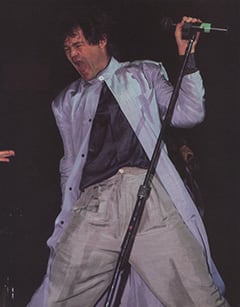
As for the music, the Monkees weren’t always on target. The first LP sounds relatively weak, though it had several fine moments—while “Valeri” and “Daydream Believer” were two of the only good things on The Birds, The Bees & The Monkees. But what great “good things” they were; someone like the Thompson Twins would kill to have anything as good on one of their albums. In between those LPs are three records that I’ve owned since the day they were released and will probably own until the day I die (and you can, too, now that Rhino Records has re-released the entire Monkees catalog). More Of The Monkees is a pop lover’s dream feast, ranging from the inspired Boyce & Hart classics to Neil Sedaka’s Buddy Holly-ish “When Love Come Knockin’,” one of the happiest love songs ever recorded. “Steppin’ Stone” is one of the few songs the Sex Pistols ever covered, and I’ve seen college kids go crazy for the last six years every time the band I’m involved with covers something like “She.” Pisces, Aquarius, Capricorn & Jones Ltd., the fourth LP, is the famous synthesizer-debut record and the beginning of psychedelic leanings—plus many, many fine pop songs. But my all-time fave is probably Headquarters, a hodge-podge of styles, ranging from the exciting Little Richard/Chuck Berry-influenced “No Time” (recorded over three years before Fogerty released “Travelin’ Band”) to the beautiful, moving, magnificent, splendid, wonderful “Shades Of Gray,” which rates as one of the ’60s best compositions—and sounds as beautiful, etc. today as it did then.
And the Monkees did write some of their own songs. Peter’s hippieish “For Pete’s Sake” wasn’t bad at all, and will always be ingrained in the minds of everyone who grew up with the show. Micky’s “Randy Scouse Git” is a really, really neat song (and a hit in England), and Micky continued writing some nice songs (as well as some clinkers) as late as the group’s final two LPs as a trio (although in fairness, it should be noted that Instant Replay includes two of the worst Goffin-King songs in history and isn’t a very good album).
Then there was Mike Nesmith. If Nesmith had done nothing other than write “Different Drum” (Linda Ronstadt’s greatest moment, one of the ’60s most perfect pop tunes) and the haunting “Joanne” (yes! yes! yes!), his place in pop history would be secure. But Nesmith had great songs as early as “Papa Gene’s Blues” and “Sweet Young Thing” on their first LP, and as late as “Good Clean Fun” and “Never Tell A Woman Yes” on their final The Monkees Present (a pretty good record). Mike Nesmith was a magnificent songwriter. Just listen to “The Kind Of Girl I Could Love.” It’s a shame he never got his just due because he was a Monkee.
I’ve always said if the original Monkees reunited for a tour, it could one of the finest reunions in pop/rock history…
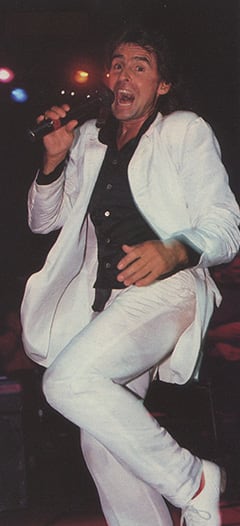
So I was skeptical and cynical when they reunited without Nesmith. They’ll do the obvious hits, probably not as good, I thought, and cash in on the MTV-inspired nostalgia. I was even skeptical when I read that Nesmith had raved about the reunion show after seeing it in Texas, saying that he almost wished he was onstage with them. After all, hadn’t he also said that he didn’t join in because it “would be like Reagan making another movie”?
Well, if you skipped the Monkees’ reunion show because you thought it was a cynical cash-in, then you missed an excellent, entertaining, fun, funny, really neat rock show. They were as charming as ever. They sound as good vocally as they did then, and they’ve aged more gracefully than, say, Crosby, Stills & Nash. Excepting “Words,” they did all the obvious hits—but they did non-obvious stuff, too, like “No Time,” “Auntie Grizelda,” the great “Goin’ Down” and (sigh!) “Shades Of Gray.” I actually got goosebumps! The band behind them was terrific—so much so that the songs sounded better (and more rock ’n’ roll-like) than they did in the ’60s. Only once—during Davy’s solo segment—did the show even approach Las Vegas mentality. They played Mike’s “Listen To The Band,” a nice gesture. They showed that “That Was Then, This Is Now” is a fine summer pop song. They were better than the last two times I saw the Stones and the last five times I saw the Kinks. They were great. If Nesmith had been there, it could’ve been one of the most entertaining shows I’ve ever seen. As it was, along with Lou Reed’s, it was the best rock show I saw this summer.
The day after the show was my birthday. I got to interview Micky Dolenz. He still has the same chipmunk voice. He’s also one of the most gracious people I’ve ever interviewed. It was really, really neat…
ON PUTTING THE CONCERT SHOW TOGETHER: “The three of us did it as a unit. (Promoter) David Fishoff put together the band and the tour, but we chose the songs. The songs kinda chose themselves. There were at least eight or 10 that we had to do, the obvious ones. The difficulty came in choosing the second eight or 10 because we had so many secondary kind of hits. We’ve tried a couple different tunes here and there—some work, some haven’t. Some we like, some we don’t. But we had to do a few. We had to do an hour, and we wanted to do all the songs full-length. We didn’t want to do any medleys because that would be a mistake. We could’ve got a lot more in, of course, but we felt that medleys would be a bit of a cheat.”
ON THEIR NEW PHENOMENAL SUCCESS: “I’m a film director in England now and when I agreed to do this last summer, I had no idea it was going to be this big. Our fans have always been enthusiastic, but I think the MTV run of the show really put it over the top and brought in a lot of new fans. Then again, there’s an awful lot of our original fans out there coming back for nostalgic reasons.”
ON ACCUSATIONS OF NOSTALGIA PEDDLING: “Well, I don’t think that you could accuse anyone of doing that. I’ve never considered it to be a ‘vice,’ you know, nostalgia and playing what people want to hear. I’ve never really cared what the media said. We’ve been very fortunate in that the press have had very little negative effect on our success, back in the ’60s, and they don’t today, really. You say we’ve taken a lot of shit, but, quite honestly, we never noticed. Because, first of all, we never had the time to read much of our own press. And, of course, the thing was so successful that if we did read any bad press, all we did was laugh, go out and play to a sold-out house and count our money. We’ve had some bad press this time around, and it still makes no difference. I don’t know why. That’s just the way it is, and there you go.”
ON THE BASIS OF THE MONKEES’ SUCCESS: “A lot of it has to do with the fact that the songs are just fundamentally good songs. To be honest, I think that anyone—well, not anyone, but any major act could record these songs and have major hits. Carole King didn’t write sh… uh, duff fung, you know. That gives us such a strong, heavy foundation that it’s very difficult to screw it up.”
ON THE MONKEES’ PLACE IN ROCK HISTORY: “I don’t think it’s so much rock ’n’ roll history as it is entertainment history. The Monkees were not, by any stretch of the imagination, a full-blown rock ’n’ roll group. We never pretended to be, and never said we were. It was only the press and magazines like Rolling Stain that perceived it that way. We were a TV show about a group, and doing music videos and that’s where it was at. They wanted to relate everything, of course, to being as pure as driven snow, to use a pun, in rock ’n’ roll back then. And the Monkees just weren’t that. The Monkees were much. closer to the Marx Brothers than a rock ’n’ roll band, actually. And it was John Lennon who originally made that comparison. That’s much closer to the truth. So no, it doesn’t bother me when the Monkees aren’t included in the greatest rock ’n’ roll bands of all time, because that’s not what it was.”
ME: Well, I think some of your songs rate right up there.
“Well, thank you. I appreciate that. I mean, I think it’s true that for all practical purposes, we sure became a rock ’n’ roll band.”
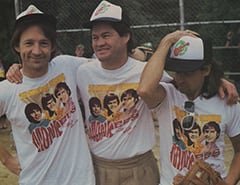
ON FUTURE MONKEE PLANS: “There’s a lot of things in the air. There’s a TV special, there’s a movie. There are a number of things that we’re talking about. It’s been kind of tricky because we’ve been on the road and everything’s taken us a bit by surprise. I really can’t give you any more information than that, honestly, but we’ll continue as long as it remains genuinely successful. It really hasn’t been over-promoted or overhyped, and that’s what’s been so exciting about it.”
ON THE STUPID CONCEPT OF A “NEW MONKEES” TV SHOW: “Well, I have to be careful what I say. I said a couple of things, and they got mad at me. But, quite simply, I agree with you. That’s my professional opinion. I thought the new Odd Couple was stupid. I think the new Star Trek idea is stupid. It’s just lame. It’s anticlimactic and unneccesary [sic]. I have a feeling it’s just business executive type of people who perceive it as something they can make money on. I don’t think it’s necessary. On the other hand, I have to wish all the kids who are going out for it good luck and everything like that.”
ON WHETHER HE’S RECENTLY TALKED TO MIKE NESMITH: “Oh, of course. Everybody’s trying to make something out of that, and, believe me, there’s nothing there. I think he kind of misses it. On the other hand, he’s just not into it. He doesn’t do this anymore. He doesn’t tour. He doesn’t record. He doesn’t sing. It’s as simple as that. And he’s also very busy doing what he does—executive movie producer—which I know because I’ve been in the same position. It’s very time-consuming. If this tour had happened a couple of months earlier, I couldn’t have done it. I had to cancel a series that I was supposed to produce and direct to do this. And I had my doubts. I was torn about it. It took me a long time to make up my mind. Because, again, we had no idea that it was going to explode into this kind of thing.”
ON A POSSIBLE “SURPRISE”. NESMITH APPEARANCE: “I kinda doubt it. I can’t imagine how that would work. I just don’t know. I can’t imagine how he’d feel very comfortable coming out and just… what would he do? Just stand there and sing a tune? I’d much rather see him do a film with us, do a movie.”
ON WHETHER HE CONTINUED PLAYING DRUMS AFTER THE MONKEES ENDED: “No, no. It’s a difficult instrument to take to parties with you.”
I hope the Monkees continue for a long time. I hope they record more songs as fine as “That Was Then, This Is Now.” I hope my kids like them as much as I did. And I hope Mike Nesmith rejoins them in some capacity. The Monkees make people happy. Ain’t nothing wrong with that.
(Editor’s note: Of course, Nesmith did join the three other Monkees onstage at Los Angleles’s [sic] Greek Theatre in late August ’86 for two songs, “Listen To The Band” and “Pleasant Valley Sunday.” Asked if he’d rejoin the band, Nesmith replied: “It’s always a possibility, if we can synch our schedules. I love these guys.”)




